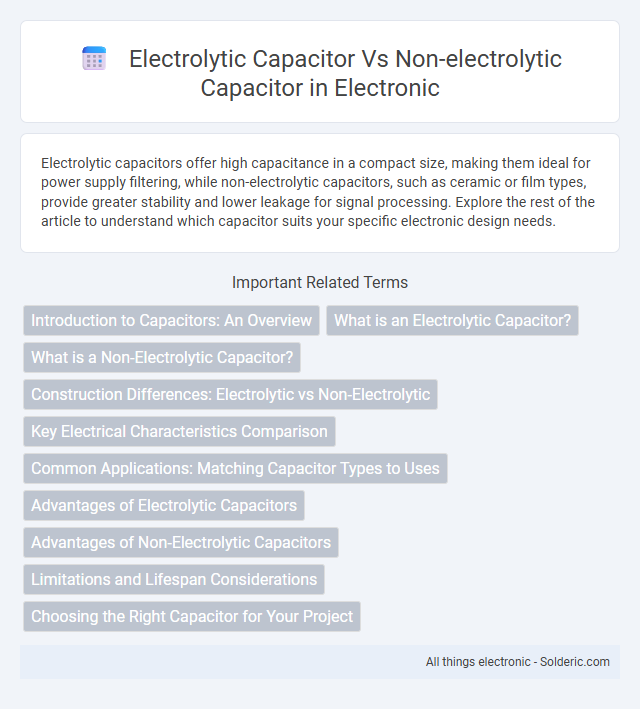Electrolytic capacitors offer high capacitance in a compact size, making them ideal for power supply filtering, while non-electrolytic capacitors, such as ceramic or film types, provide greater stability and lower leakage for signal processing. Explore the rest of the article to understand which capacitor suits your specific electronic design needs.
Comparison Table
| Feature | Electrolytic Capacitor | Non-Electrolytic Capacitor |
|---|---|---|
| Dielectric Material | Electrolyte (liquid or gel) | Solid dielectric (ceramic, film, mica) |
| Capacitance Range | 1 uF to several thousand uF | 1 pF to several uF |
| Polarity | Polarized (must respect polarity) | Non-polarized (can be connected either way) |
| Voltage Rating | Typically 6V to 500V | Typically up to 1000V or more |
| Equivalent Series Resistance (ESR) | Higher ESR | Lower ESR |
| Frequency Response | Limited high-frequency performance | Better high-frequency stability |
| Size | Larger for same capacitance | Smaller for same capacitance |
| Applications | Power supply filtering, audio circuits | RF circuits, timing circuits, coupling/decoupling |
| Lifespan | Limited by electrolyte drying out | Longer lifespan, more stable |
Introduction to Capacitors: An Overview
Electrolytic capacitors utilize a liquid electrolyte to achieve high capacitance values, making them ideal for applications requiring large energy storage in compact sizes. Non-electrolytic capacitors, such as ceramic or film types, offer lower capacitance but excel in stability, low leakage current, and high-frequency performance. Selecting between these capacitor types hinges on balancing capacitance needs, voltage ratings, and frequency characteristics for optimal circuit functionality.
What is an Electrolytic Capacitor?
An electrolytic capacitor is a type of capacitor that uses an electrolyte as one of its plates to achieve a higher capacitance per unit volume compared to non-electrolytic capacitors. It consists of an anode made from a metal such as aluminum or tantalum, a thin oxide layer serving as the dielectric, and a liquid or solid electrolyte acting as the cathode. Electrolytic capacitors are polarized components primarily used in applications requiring large capacitance values, such as power supply filtering and energy storage.
What is a Non-Electrolytic Capacitor?
A non-electrolytic capacitor is a type of capacitor that uses a solid dielectric material such as ceramic, film, or mica instead of a liquid or gel electrolyte, providing higher stability and longer lifespan compared to electrolytic capacitors. These capacitors excel in high-frequency applications and circuits requiring low leakage current, making them ideal for precision electronic devices. Understanding the differences between electrolytic and non-electrolytic capacitors helps you select the right component for your circuit's reliability and performance needs.
Construction Differences: Electrolytic vs Non-Electrolytic
Electrolytic capacitors feature an anode coated with an oxide layer acting as a dielectric, a liquid or solid electrolyte as the cathode, and a polarity marking due to their polarized nature, enabling high capacitance values in compact sizes. Non-electrolytic capacitors, such as ceramic, film, or mica types, utilize non-polar dielectric materials like ceramic, plastic films, or mica between two metal plates, resulting in stable capacitance and non-polar construction. The construction difference impacts voltage rating, capacitance range, leakage current, and application suitability, with electrolytic capacitors suited for high capacitance and non-electrolytics preferred for signal and high-frequency circuits.
Key Electrical Characteristics Comparison
Electrolytic capacitors typically offer higher capacitance values, ranging from 1 uF to several thousand uF, with voltage ratings up to 500V, making them suitable for filtering and energy storage in power supplies. Non-electrolytic capacitors, such as ceramic and film types, provide lower capacitance values (picofarads to microfarads) but exhibit superior stability, lower equivalent series resistance (ESR), and longer lifespan, ideal for signal processing and high-frequency applications. Your choice depends on specific electrical requirements like capacitance, voltage rating, frequency response, and tolerance to temperature variations.
Common Applications: Matching Capacitor Types to Uses
Electrolytic capacitors are commonly used in power supply filtering, audio equipment, and signal coupling applications due to their high capacitance and voltage ratings. Non-electrolytic capacitors, such as ceramic or film types, excel in high-frequency circuits, RF applications, and precision timing because of their stability and low equivalent series resistance (ESR). Selecting the appropriate capacitor type ensures optimal performance and longevity in specific electronic circuit designs.
Advantages of Electrolytic Capacitors
Electrolytic capacitors offer high capacitance values in a compact size, making them ideal for energy storage and filtering applications in power supplies and audio equipment. Their ability to handle higher voltage ratings and provide stable performance under varying temperature conditions enhances circuit reliability. Cost-effectiveness and wide availability further contribute to their dominance in electronic component markets compared to non-electrolytic capacitors.
Advantages of Non-Electrolytic Capacitors
Non-electrolytic capacitors offer superior stability and longer lifespan compared to electrolytic capacitors, making them ideal for precision circuits. They exhibit low leakage current and low equivalent series resistance (ESR), enhancing overall circuit performance and reliability. Your choice of non-electrolytic capacitors can improve thermal tolerance and reduce the risk of failure in high-frequency applications.
Limitations and Lifespan Considerations
Electrolytic capacitors typically have higher capacitance values but suffer from shorter lifespans due to electrolyte drying out and increased leakage current over time, especially under high temperature and voltage stress. Non-electrolytic capacitors, such as ceramic or film types, offer longer lifespan and better stability but are limited in capacitance and voltage ratings. You should consider the operating environment and required longevity when choosing between these capacitor types to ensure reliable circuit performance.
Choosing the Right Capacitor for Your Project
Electrolytic capacitors offer high capacitance values ideal for power supply filtering and bulk energy storage, while non-electrolytic capacitors, such as ceramic or film types, provide better stability and lower leakage for high-frequency and precision applications. Consider your project's voltage rating, capacitance requirements, and size constraints when selecting between electrolytic and non-electrolytic capacitors to ensure optimal performance. Your choice impacts circuit reliability, noise levels, and lifespan, making capacitor selection critical for success.
electrolytic capacitor vs non-electrolytic capacitor Infographic

 solderic.com
solderic.com